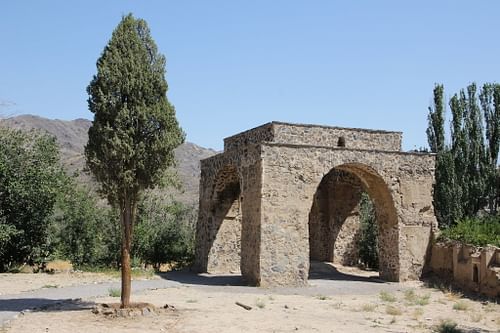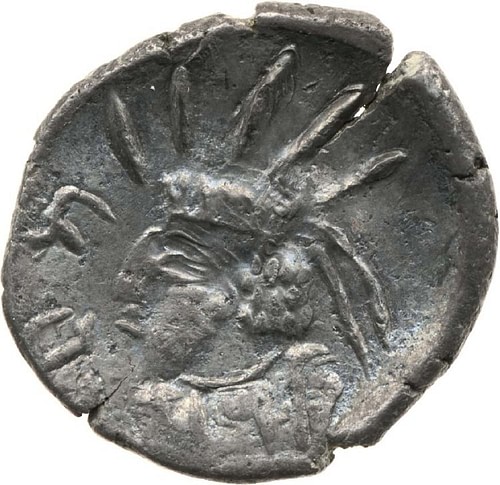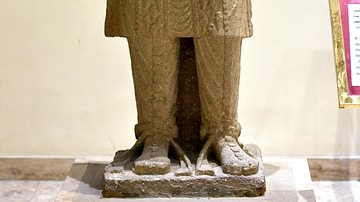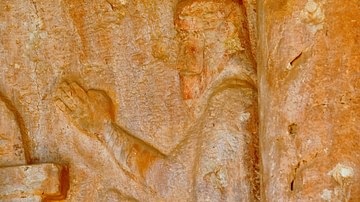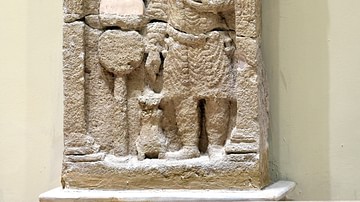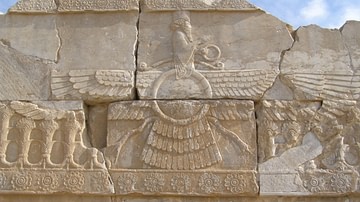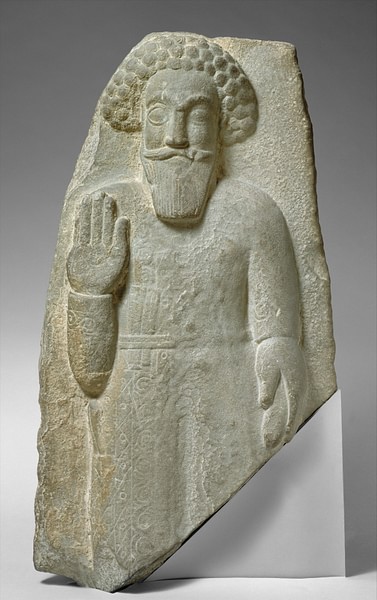
Parthian Religion might be best described with two words: inclusive and evolving. As Parthia's empire held within it a variety of cultures, the Parthians wisely left each to their own beliefs and traditions, like the Seleucid Empire and the Persian Achaemenid Empire before them. While Parthia allowed Jews and Christian enclaves to thrive, the three leading beliefs were the Greek pantheon, Zoroastrianism, and Mithraism. But what did the Parthians themselves believe? Considering they left no historical record as to their cultural heritage, discovering the Parthian belief system may seem challenging, but starting with what was practical and prominent in their daily lives and considering from where they came, to where they were going, will help. Initially, it appears, as Persian and Greek cooperation were essential to the success of the Parthian Empire, the Parthians flirted with keeping both nation's customs, but once they stood on their own, they began to identify with Mithra.
Scythian Roots & Greek Deities
It is generally accepted the Parthians were of Scythian cultural descent. Rising from the flat steppe east of the Caspian Sea, the Parthians, like the Scythians, were a horse-riding, arrow-shooting military machine with which few could reckon. The Parthian Empire would adopt and use many of Scythia's military tactics and survival strategies. Nonetheless, the acculturation of Scythian ways of life would include Scythian forms of belief. With the flat expanse of the steppe over which they trod, a prominent characteristic in daily Scythian life would have been the sky as it met the earth at the horizon. One manifest feature, from which the steppe offers little escape, would have been the sun. Another prominent element, as with many ancient cultures, was that of fire. Offering security against wild beasts at night and everyday practical utility in cooking and metallurgy, fire in ancient times was essential and held considerable symbolic sway. It is not surprising then that for the Scythians and Parthians, the earth, sky, sun, and fire came to hold particular theological value.
Herodotus relates eight deities the Scythians worshipped. As Barry Cunliffe states, "These he names, giving their Greek equivalents. It is clear from his presentation that three ranks are to be recognized" (167). In the first rank is Tabitha/Tabiti (Hestia). In the second, Papaeus (Zeus) and Api (Mother Earth). The third rank includes Goetosyrus (Apollo) and Argimpasa (Aphrodite). Though Herodotus omits their Scythian names, the fourth rank includes Hercules, Ares, and Poseidon. For the Scythians and other Indo-Iranian peoples, Tabitha, at the head of the pantheon, is the goddess of fire and hearth. Tabitha also served as the protector of the king, who often served as an intercessor between her and the people. The Royal Hearth, which Tabitha consecrated, also functioned as the holy object by which the solemnity of an oath is recognized.
The earth-meets-sky visual, expresses itself in the belief, when the sky god, Papaeus, made union with Mother Earth, all other gods were born. The everyday prominence of the sun in the atmosphere is thought to be associated with the Scythian Apollo, Goetosyrus. Another prominent physical feature with which the Scythians were familiar was the sights and sounds of war. Scythia's war-god held prominence all over Scythia. Open-air altars of brushwood were erected throughout the provinces on which sacrifices of horses and cattle were made. The identity of Scythians as a warlike culture, with Ares as a patron, was promoted, giving regular troops and commoners common cause with a prominent deity figure of their nation.
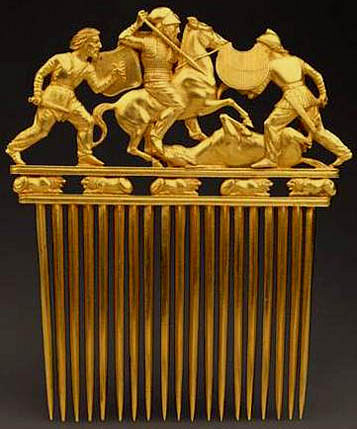
New Contacts, New Religions
While Herodotus gives his understanding of Scythian belief from the standpoint of the Greek pantheon with which he was familiar, of the Scythian deities, he says the Scythians had no images, altars or temples. Indeed, abundant excavations of Scythian burial mounds reveal images of nomadic hunting and warrior life and an interesting and ample prey/predator theme, but few gods, and then, only of Argimpasa, their mother-goddess. As Cunliffe mentions: "The deities of the upper ranges of the pantheon, Tabitha, Papaeus, and Api do not seem to have been anthropomorphized, or at least no certain depictions of them are known" (276). Scythian nomadic beliefs were, therefore, more closely tied to nature than to deities who controlled nature.
As the Parthians moved south off the steppe of central Asia into the east-west cultural corridor of lower Eurasia to take over the weakened Seleucid Empire, they came into contact with more clearly defined anthropomorphic religions. The Seleucids, like the Persians before them, practiced religious tolerance. While allowing others their traditions, the Seleucids retained their pantheon of gods, already of widespread influence in the ancient world. After Parthia's first king, Arsaces I (r. 247-217 BCE), threw off the yoke of Seleucid control in the east, the Parthians eventually took over the more strongly held Seleucid territories in the west. With that, they came in direct contact with the Greeks.
Like the Seleucids before them, the Parthians allowed the Greeks their traditions, and it appears (at least at first) even adopted their customs. Initially, the Parthian belief system would have primarily been a worship of the elements of fire, earth, sky, and sun. While Greek deities kept these elements, they were infused more definitively with human characteristics. Thus, as Apollo, the Greek sun-god, would guide the sun's trajectory with his chariot, Hestia made the hearth and fire her specialty. As Poseidon ruled the waves, Ares' domain would be that of war, and Zeus' realm that of the sky, and so on. Yet, the elements - rivers, lakes, wells, trees, the sea, and stones - were still revered in western Parthia. Meanwhile, in other parts of the empire, Babylonians still venerated Ishtar and Bel, an enclave of Jews in Mesopotamia worshipped Yahweh, sun and moon gods were venerated at Hatra, and Christianity gained footing east of the Tigris toward the end of the Parthian period. However, besides the Greek pantheon, the two most widespread belief systems during Parthian times were Zoroastrianism and Mithraism.
Zoroastrianism within the Empire
One of the belief systems that remained intact from Persia through Seleucid and Parthian rule and would find a resurgence with the Sassanian Empire was Zoroastrianism. Probably from eastern Persia, its founder, Zoroaster, was at first a priest of a polytheistic belief system headed by the god Ahura Mazda. One day a bright celestial being, sent from Ahura Mazda, appeared to Zoroaster by a river telling him there was only one god, the wise uncreated one, Ahura Mazda. Embracing a theology of good versus evil, followers were to lead a life of basic goodness: thinking good thoughts, saying right words, and doing good deeds. Abandoning animal sacrifice, Zoroastrians lit altars of fire kept ablaze continuously.
The symbolism of fire represented cleansing and purity. Fire, which gave light to a dark world, symbolized Ahura Mazda himself but also his followers were to strive to have illuminated minds. About Zoroastrianism in Parthia, Jenny Rose writes:
Until recently, the lack of internal material from Seleucid and Parthian Iran contributed to the view the Zoroastrian religion had been neglected until it was 'restored' by the Sasanians. But written data on ostraca, rock reliefs, parchment, and coins deciphered in the past few decades contradict this view, pointing instead, to the continuity and development within the religion during this period. (loc 260)
For example, Avestan names (Avestan is the language of Zoroastrian scripture) and calendar inscribed on Parthian ostraca appear at Nippur, southeast of Baghdad; and in a wine cellar at Nisa. Similar names were also found on a Parthian legal document from Avroman in Iranian Kurdistan. Other Parthian coins showing altars of fire also reflects at the least an appreciation of Zoroastrian religious practice. Interestingly, as Zoroastrianism would evolve to include Mithra as a Yazata or head-deity under Ahura Mazda, it appears the Parthians developed their own leaning toward Mithra.
Mithraism within the Empire
Sometime between 2000 and 1500 BCE, Aryan tribes swept south of the Russian steppes into India and Iran. One deity they brought with them was Mithra. As Mithra (or Mitra) established himself in India and is lauded in the Rig Veda, his fame spread throughout Eurasia. Around the same time, Zoroastrianism spread alongside Mithra and other gods, and by the 5th century BCE, Zoroastrianism would praise Mithra's attributes as he was elevated just under Ahura Mazda. Parvaneh Pourshariati comments on the Parthian view:
It is true that the Parthians have been credited with the first codification of the Avestan holy book. They also used Zoroastrian holy months in their calendar. And it well may have been the case that some Parthian dynasts were orthodox Zoroastrians. But new evidence, as well as a reassessment of some of the data already at our disposal, makes the case that Mithra worship was the most widespread current of worship in traditional Parthian domains. (358-59)
An example of departure comes when by 140 BCE Parthia took over the province of Persis, homeland of the Persians, and hub of Zoroastrianism. In potent opposition, the Avestan Vendidad text (141 BCE-224 CE) named Parthian territories as evil because of their "sins of unbelief." Parthia was also reprimanded for burying and burning their dead, a practice forbidden by Zoroastrian convention. Moreover, Pourshariati suggests the Burzin Mithra fire altar was a personal fire by a powerful Parthian, and its meaning, “Exalted is Mithra,” indicates Mithra as the unabashed sole figure of worship (364).
Furthermore, the name Mithridates ("gift of Mithra") was popular among many kings during the Parthian era. The two most important Parthian kings, Mithridates I and II (r. 171-132 BCE and 124-91 BCE) both lauded his name. Two other kings from Parthia, two from Kios, six kings from Pontus, likewise claimed it and so did kings from Commagene, Iberia, and Armenia. Like the popular choice of the name Mohammad by the adherents of Islam, the theophoric name choice of Mithridates by so many kings and people of different countries over a significant span of history reflects a conscious recognition and reminder of who Mithra was and the vital part he played in their cultural heritage.
That Zoroastrianism later included Mithra in their religious landscape in such a significant way may reflect pressure to stay relevant because of Mithra's general popularity. When Parthia began to take over central Eurasia, his fame would have been known by the Parthians, and they may have similarly embraced him. In present-day Ashkabad in Turkmenistan, remains of a place of worship from the Parthian period were discovered with the inscription, "mehriyan" or "place of Mithra." Ostraca, with the name Mithra on them more than other deities, are found at Nisa, a Parthian capital. On a relief from a temple of Commagene in the Taurus mountains, Mithra, as a god in his own right - with Phrygian cap, Persian trousers, and radiating rays - stands in solidarity with King Antiochus I of Commagene (r. 70 - c. 38 BCE).
Moreover, as coins that date to the 5th and 4th centuries BCE attest, Parthian dress was, at first, similar to Greek. By the 2nd century BCE, Parthian coins show Mithridates II and Artabanus I (r. 127-124/3 BCE) “wear as their official costume the nomadic trouser-suit, which was associated with Iranian-speaking peoples of the pre-Hellenistic period.” (Curtis and Stewart, 3) This dress would be the norm through the rest of their reign. Finally, dropping the title of "philhellene" from the reverse legends of his tetradrachms, on the reverse of a Parthian coin, king Artabanus II (r. 12-38/41 CE) is shown kneeling before an Apollo-like god thought to be Mithra, while a definitive Mithra appears on the face of a Parthian silver coin, dating to the 1st-2nd century CE. Thus, literary, historical, and physical evidence appears to show Parthians parting from Greek and Persian traditions seeking to establish their own belief system that more fully embraced Mithra. As Vesta Curtis says, “Mithra was clearly a favored deity among the Parthians” (Curtis and Magub, 32).
Mithra's Appeal
While religious tolerance was a hallmark of Parthian government and key to their longevity, the appeal of Mithra for the Parthians may have been the allure Mithra held for everyone. One might say he was an all-in-one god. Fully anthropomorphized, he embodied in one person the attributes of many gods. From a political standpoint, embracing Mithra did two things for Parthia; it gave it a unique standing and identity different from the Greeks and Persians while providing common ground with both. The iconography of Mithra as a sun god with rays emanating from Mithra's head is amazingly like other depictions of Apollo. Moreover, Mithra, as a warrior, and his association to fire and sky, reveals common qualities with Ares, Hestia, and Zeus. Concerning interactions with the Persians, fire was a major element for Zoroastrian ritual life. Mithra himself was a god of fire included in the Zoroastrian celestial hierarchy. Created by and second only to Ahura Mazda, he was also a warrior for Ahura Mazda.
For the Parthians, Mithra would also have held a personal attraction. As the Parthian Empire returned to its roots, it is interesting that Mithra was a deity introduced by a culture that, like the Parthians, came off the steppe born on horseback. The Mithra of the Aryans would have particular appeal to the Parthians. He was a warrior and sometimes horse-archer and killed devils with a bow. That he owned vast wide expanses of land and blessed warriors on horseback did not hurt either. As Mithra was also the god of fire, this, too, would have significant appeal to the Parthians. Fire was associated with contracts, agreements, oaths, and truthfulness. Similarly, Scythia's chief deity, Tabitha, was the goddess of fire, and it was by her hearth that oaths were made. Moreover, as a nation on horseback, fighting and roaming under open skies, the sun would have held an imminent place for the Parthians. Invoking it to benefit them would have been an essential ritual. With Mithra, they could do that in a personal way since he was also the god of the sun. Ultimately, Mithra gave the Parthians a way to create their own identity, especially since he was a god who addressed their concerns and was similar to themselves.
